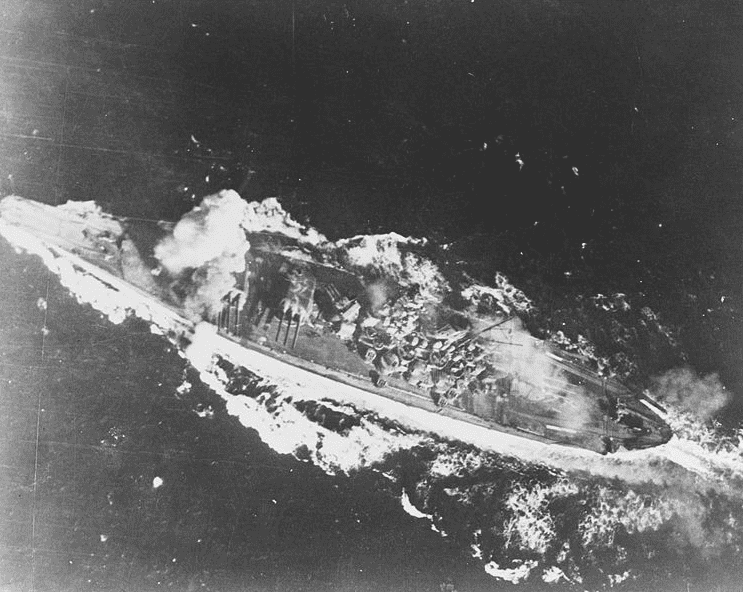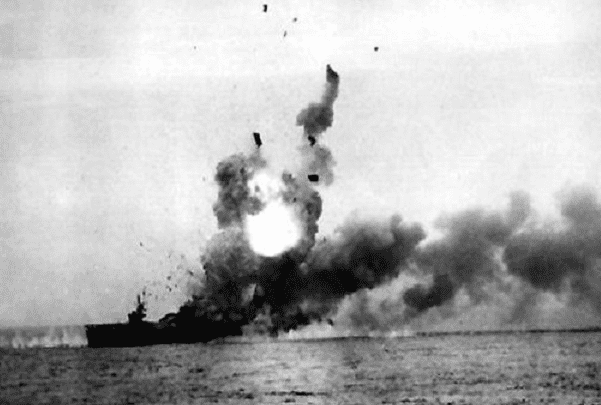The four-day Battle of Leyte Gulf, a WWII clash between the U.S. Navy (with support from Australian vessels) and the Imperial Japanese Navy, was one of the biggest naval battles in history. During 23-26 October 1944, over 300 warships and 1,800 planes fought a series of battles to determine the fate of the Japanese stronghold on the Philippine islands.
When the fighting was over, the Americans had achieved a resounding victory and the Japanese navy ceased to be a viable force for the remainder of the war.

Not only had the Japanese lost more than 10,000 men, 27 ships and almost all of their planes, but their failure at the Battle of Leyte Gulf meant the American takeover of the Philippines (which had begun October 20 with an invasion of the island of Leyte) could proceed. The Japanese navy lost access to its vital supplies of oil in Southeast Asia, and its warships that survived the Battle of Leyte Gulf basically spent the rest of the war stuck in port.
The American navy lost more than 1,500 men and 6 ships, but its victory at the Battle of Leyte Gulf was instrumental in re-capturing the Philippines, in turn making almost inevitable the final Japanese surrender: the formal surrender ceremony took place in Tokyo Bay on the deck of the U.S. battleship Missouri on 2 September 1945.

The climax of the Battle of Leyte Gulf occurred on 25 October 1944, during which three major battles were fought: the Battle of Surigao Strait, the Battle off Samar, and the Battle off Cape Engano. Two of these engagements are especially noteworthy in the annals of naval warfare. The Battle of Surigao Strait was the last time that battleships would square off against one another; carrier-based aircraft power was bringing the era of the heavily-armored, heavily-gunned battleship to an end. The Battle off Samar saw the first operation of the terrifying new Japanese “Special Attack Force” – kamikaze (suicide) planes.
Many Americans first heard of the Battle of Leyte Gulf when they picked up their papers on October 25, such as this front-page article published by the Oregonian.
Here is a transcription of this article:
U.S. Planes Hit 2 Big Nippon Fleets in Naval, Air Battle off Philippines
Japs Claim 13-3 Score in Sea War
Associated Press Staff Writer
American carrier planes are attacking Japanese battleships and cruisers moving eastward in the central Philippines, Adm. Chester W. Nimitz announced Tuesday from the Pacific fleet headquarters at Pearl Harbor, and Axis reports made the unconfirmed claim that enemy planes were turning it into an aerial slugging match by attacking American warships.
Nimitz’ terse communiqué indicated there were two groups of Japanese warships, specifying they were moving through the Sibuyan and Sulu seas.
(German radio was heard in London saying both land-based and navy-based planes of the Japanese launched large-scale attacks Tuesday on the American invasion fleet in Leyte Gulf and also were attacking a second battle fleet “in waters not further specified.”
(The broadcast said “the battle is still going on.”)
Nimitz’ communiqué said further details were unavailable.
Japs Claim 16 Ships
Adm. William F. Halsey, Jr., sharp-tongued leader of the Third Fleet which is sending its carrier planes against the Japanese warships, three days ago observed aboard his flagship “we may have to go in and dig the Japanese fleet out.”
Tuesday it appeared that the Japanese, stung by the invasion of the Philippines, were aroused to move toward the scene where Gen. Douglas MacArthur’s forces have won expanding beachheads and are springing a trap on Japanese in the interior of Leyte island.
Official Pearl Harbor reports that carrier planes of Adm. William F. Halsey, Jr.’s, 3d Fleet have opened attacks on Japanese battleships and cruisers on the west side of the Philippines were followed by a Japanese communiqué reporting three Japanese warships had been sunk in the raging naval and air battle.
The communiqué claimed 11 American warships had been sunk and two damaged by naval gunfire and submarine action.
Air Attacks Specified
Tokyo radio, in broadcasts recorded by the Federal Communications Commission, asserted “Japanese naval fire sank four aircraft carriers, two large cruisers and one destroyer” in an intensifying sea battle “east of the Philippines Wednesday (Tokyo time).”
“More than four enemy transports,” the broadcast asserted, were sunk by Japanese submarines in the same action.
The action, Tokyo said, began Tuesday.
Both Nimitz and Tokyo reports suggested that the Japanese fleet had come out of hiding for the first time since its defeat in the Philippines Sea west of the Marianas last June.
(The Blue Network previously had recorded a Tokyo broadcast that “naval and air” units of the Japanese had attacked the Americans, but the Federal Communications Commission recording specified only air attacks, omitting the possibility of a direct fleet engagement.)
Yank Radios Silent
Radio silence protected operations of the American fleet and perhaps also accounted for the fact that the usual time for issuance of recent communiqués by MacArthur passed without any word from him.
Strictest radio silence always is necessary for fleet security when the armadas are in striking distance.
The wording of the communiqué – “enemy forces moving eastward through the Sibuyan and Sulu seas” – might indicate that two Japanese forces were on the prowl.
One could be moving through the Sulu Sea from the southwest, planning to move on through the Mindanao Sea in the southwest Philippines toward Leyte island.
The other could be moving through the Sibuyan Sea southeastward toward the Visayan Sea and Leyte island, which Gen. Douglas MacArthur’s forces invaded last week.
Note: An online collection of newspapers, such as GenealogyBank’s Historical Newspaper Archives, is not only a great way to learn about the lives of your ancestors – the old newspaper articles also help you understand American history and the times your ancestors lived in, and the news they talked about and read in their local papers. Did you or any of your family serve in World War II? Please share your stories with us in the comments section.
Related Articles:
